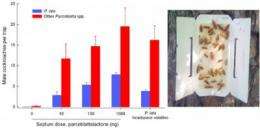Cockroach 'let's hook up' chemical signal could benefit endangered woodpecker

A North Carolina State University discovery of the unique chemical composition of a cockroach signal -- a "Let's hook up" sex pheromone emitted by certain female wood cockroaches to entice potential mates -- could have far-ranging benefits, including improved conservation of an endangered woodpecker.
Dr. Coby Schal, Blanton J. Whitmire Professor of Entomology at NC State and the corresponding author of a paper describing the discovery, says that the study, published the week of Dec. 19 in Proceedings of the National Academy of Sciences, advances the knowledge of fundamental biological and chemical properties of an important North American cockroach genus that serves as both a beneficial forest insect and as a pest in homes.
Parcoblatta lata is the largest and most abundant of the wood cockroaches. It also serves as the favored meal of the endangered red-cockaded woodpecker. Schal says that the study, which characterized the pheromone and produced a synthetic version of it, could help scientists determine whether certain habitats have enough woodpecker food. If the synthetic pheromone attracts large numbers of adult male P. lata cockroaches, Schal says, then the roach supply is probably ample. Provided that other aspects of the habitat are also right, the area could be a suitable home for red-cockaded woodpeckers.
Besides feeding woodpeckers, Parcoblatta adult males are excellent flyers that occasionally infest houses after being attracted to porch lights. The pheromone could help control wood roaches near homes, Schal says.
Schal and colleagues from New York and California combined a number of study methods to understand P. lata's aphrodisiac. The team used gas chromatography, in which compounds are separated in a controllable oven, to separate it from other chemical compounds that the roaches produce. By connecting this instrument to the antenna of P. lata and monitoring its electrical activity, the researchers zeroed in on the biologically active compound. They then used nuclear magnetic resonance to determine the pheromone's chemical structure. Finally, they made a synthetic version of the compound to see if it would attract adult male P. lata.
It did. Perhaps surprisingly, it attracted a few other Parcoblatta species, as well. One common wood roach, however, was conspicuously absent: Parcoblatta pennsylvanica, which ignored the synthetic pheromone. As its name implies, P. pennsylvanica has populations into the Midwest and mid-Atlantic states.
"Parcoblatta cockroaches are endemic to North America; unlike pest cockroaches, they were not introduced from other places," Schal says. "The compound we identified is a major component of a multi-component sex pheromone blend. So learning that the chemical we identify in this paper attracts some Parcoblatta species but not others tells us something about their evolutionary history."
The roaches that respond to this pheromone probably make up a group of closely related species, Schal says, which together diverged from other Parcoblatta species that either can't smell this chemical or are attracted to it only when it's combined with other, yet to be identified, pheromone components.
More information: "An unusual macrocyclic lactone sex pheromone of Parcoblatta lata, a primary food source of the endangered red-cockaded woodpecker" by Dorit Eliyahu, et al. Published: Dec. 19, 2011, in Proceedings of the National Academy of Sciences.
Journal information: Proceedings of the National Academy of Sciences
Provided by North Carolina State University

















